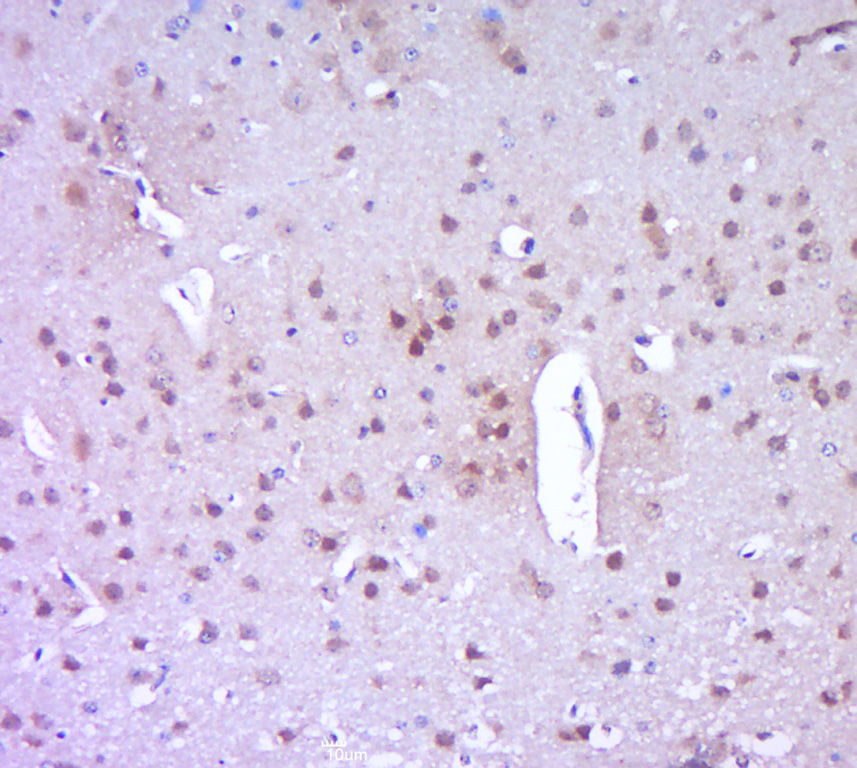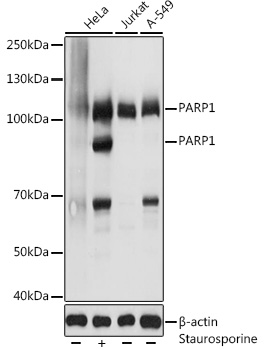anti-PARP-1 [ARTD1] (human), pAb
AG-25T-0002
ApplicationsImmunoPrecipitation, Western Blot, ImmunoCytoChemistry, ImmunoHistoChemistry
Product group Antibodies
ReactivityHuman, Monkey, Mouse
TargetPARP1
Overview
- SupplierAdipoGen Life Sciences
- Product Nameanti-PARP-1 [ARTD1] (human), pAb
- Delivery Days Customer10
- ApplicationsImmunoPrecipitation, Western Blot, ImmunoCytoChemistry, ImmunoHistoChemistry
- CertificationResearch Use Only
- ClonalityPolyclonal
- Gene ID142
- Target namePARP1
- Target descriptionpoly(ADP-ribose) polymerase 1
- Target synonymsADPRT, ADPRT 1, ADPRT1, ARTD1, PARP, PARP-1, PARS, PPOL, Poly-PARP, pADPRT-1, poly [ADP-ribose] polymerase 1, ADP-ribosyltransferase (NAD+; poly (ADP-ribose) polymerase), ADP-ribosyltransferase NAD(+), ADP-ribosyltransferase diphtheria toxin-like 1, DNA ADP-ribosyltransferase PARP1, NAD(+) ADP-ribosyltransferase 1, poly (ADP-ribose) polymerase family, member 1, poly(ADP-ribose) synthetase, poly(ADP-ribosyl)transferase, poly[ADP-ribose] synthase 1, protein poly-ADP-ribosyltransferase PARP1
- HostRabbit
- Protein IDP09874
- Protein NamePoly [ADP-ribose] polymerase 1
- Scientific DescriptionPARP-1 (ARTD1) is involved in the base excision repair (BER) pathway, by catalyzing the poly(ADP-ribosyl)ation of a limited number of acceptor proteins involved in chromatin architecture and in DNA metabolism. This modification follows DNA damages and appears as an obligatory step in a detection/signaling pathway leading to the reparation of DNA strand breaks. PARP-1 positively regulates the transcription of MTUS1 and negatively regulates the transcription of MTUS2/TIP150. It forms a complex with EEF1A1 and TXK that acts as a T-helper 1 (Th1) cell-specific transcription factor and binds the promoter of IFN-gamma to directly regulate its transcription, and is thus involved importantly in Th1 cytokine production. - Polyclonal Antibody. Recognizes human PARP-1. Cross-reacts weakly with mouse and monkey PARP-1. Source: Rabbit. Applications: ICC, IHC, IP, WB. Liquid. Contains 0.1% sodium azide. PARP-1 (ARTD1) is involved in the base excision repair (BER) pathway, by catalyzing the poly(ADP-ribosyl)ation of a limited number of acceptor proteins involved in chromatin architecture and in DNA metabolism. This modification follows DNA damages and appears as an obligatory step in a detection/signaling pathway leading to the reparation of DNA strand breaks. PARP-1 positively regulates the transcription of MTUS1 and negatively regulates the transcription of MTUS2/TIP150. It forms a complex with EEF1A1 and TXK that acts as a T-helper 1 (Th1) cell-specific transcription factor and binds the promoter of IFN-gamma to directly regulate its transcription, and is thus involved importantly in Th1 cytokine production.
- ReactivityHuman, Monkey, Mouse
- Storage Instruction-20°C,2°C to 8°C
- UNSPSC12352203





